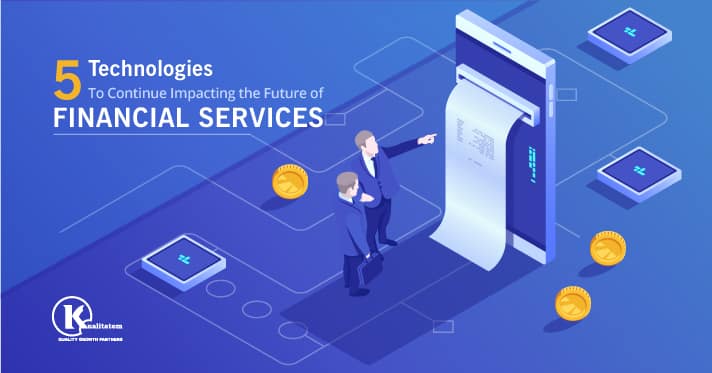5 Technologies To Continue Impacting the Future of Financial Services

- November 22, 2018
- Kualitatem
All praises to the latest technological discoveries, the banking and financial services industry have experienced a major disruption at a progressive pace. Observing the trends in the past few years, traditional as well as non-traditional fintech companies have begun to understand that technology collaboration may be the best path to long-term growth, success, and customer retention.
Senior Atos’ Senior VP Global Financial Services and Insurance, Dan Cohen believes that the financial institutions, particularly with a continuous wave of FinTech innovation and emerging technologies such as Blockchain have created an upheaval in the market. Every new technology does come with threats, however, it does open up a horizon of new prospects for Financial Services to re-invent their business strategies for a thriving future.
Primarily, these future technologies not just help to focus more on customer-centric and efficient business ways, rather they provide a more targeted and secure approach to adopting these intelligent solutions. Using this technology as the main driving force in the future, organizations will quite likely be able to restructure themselves with a more competitive and responsive outlook to marketplace needs.
Listed below are top 5 technologies that will impact the future of financial services for the better:
1. Hybrid Cloud
Cloud computing has rapidly taken center stage within the banking sector, with a number of banks searching for an optimum solution that comprises of traditional IT, public as well as private clouds. It is being seen that a vast majority of banking and other financial institutions are shifting to an enterprise-wide hybrid cloud strategy.
Through hybrid cloud technology, banks enjoy the adaptability and benefits of using a private and public cloud, while taking care of data security, governance, and compliance matters seriously. Hybrid cloud helps to reduce costs and improve operational proficiency, create new revenue generation opportunity and above all, further build their product/services portfolio.
2. Robotic Process Automation (RPA)
It has been observed that robotic process automation (RPA) has significantly helped financial institutions fast-track their growth by implementing pre-programmed procedures across a range of structured and unstructured data. This intelligent automation process renders the power to learn from previous decisions and data patterns to make final decisions by themselves. This means reduced cost of administrative and regulatory processes cost by at least 50% while enhancing the quality and delivery speed.
In addition to this, RPA in the banking sector also makes compliance more intelligent and secure by keeping records of automated processes, automatically generating reports for an auditor, and here’s the best part, it removes the chances of any kind of human error. Since software robots are intuitive and easy to re-configure, anyone can easily tweak and update regulations whenever needed.
3. Artificial Intelligence (AI)
Artificial Intelligence, or AI, has been a buzzword for a while now. With an increased level of interest developing in AI in consequence of both capabilities and business needs, the profitable growth of structured and unstructured data, accessibility to the evolving technologies, intensifying pressures owing to new competition, amplified consumer expectations altogether have created a perfect scenario for extensively adopting artificial intelligence in financial services.
Streamlining office operations, compliance, customer experience, product delivery, risk management, and marketing are among a whole list of endless pervasive benefits that AI is offering within the banking and other financial domains. Financial organizations today can sustain large archives of data for every decision made.
4. Blockchain
Even in the future, blockchain will continue to have a transformational influence on the banking industry. A wide majority of banks globally are in the process of implementing blockchain technology to increase functional efficiency, cost-effectiveness, and data security throughout the entire continuum of financial services they offer.
A number of financial institutions have already started testing the use of blockchain for inter-bank transfers, payments, fraud reduction, customer information, and loan processing. It will continue to offer incredible benefits, including streamlining and automating processes through smart contracts parallel to what it offers at present. However, clear guidelines need to be implemented on how banks should use a disruptive technology like blockchain.
5. Smart Machines
Smart Machines are rapidly changing the way we work around. Smart things, or robots, working on behalf of their owners at home, auto-driven vehicles, concierge services, and a lot more examples can be quoted on how we have become dependent on technology to handle such tasks for us. Likely to modify these go-to-market strategies, banks must also begin discovering the business, legal, and compliance benefits smart machines can offer.
Will the financial sector be able to keep pace with these emerging technologies?
Seeing how rapidly past technologies became a part of the business functionality, a new movement of emerging technologies will combine with the existing technologies and the power of data to set new technology standards. However, the prioritization and investment in these budding technologies will, of course, fluctuate, depending on the business model and strategic goals of every organization individually. For example, in comparison to the whole marketplace not anticipating to invest much in blockchain technology right now, the financial services industry rather considers it at a high priority.
It is imperative for all financial organizations to adopt these emerging technologies as a ‘core capability,’ with uniform engagement throughout the organization. Furthermore, the focus of every deployment must be on both internal and external human experiences, apart from focusing on revenue, profit, and cost savings.











